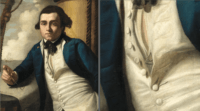Sailing master, and rookie Freemason, twenty-two years William Bligh, seen posing here in silk cravat and bob-wig civilian aplomb; his shirt pinned with a masonic square and compass badge (enlarged). *
Bligh’s patron at The Royal Society, Sir Joseph Banks, is known to have been a Freemason. Likewise Bligh’s business friend and protégé, Duncan Campbell, his wife’s rich uncle was also a Freemason. Good old Uncle Campbell managed to secure Bligh’s command of the Bounty, to collect breadfruit plants, while the Admiralty focused upon gaining a strategic advantage over French designs. Powerful and wealthy, Campbell was an absentee planter and merchant with interests in the West Indies. He was also involved in the slave trade; was an overseer of the infamous Thames prison hulks; and owned several trading ships. Campbell had entrusted Bligh to command three of his ships on round trips to the West Indies for a substantial salary. It was here that before joining the Bounty, Fletcher Christian had twice sailed under Bligh in one of Campbell’s ships, Britannia.
The mystique of Freemasonry makes it difficult to connect all the interests of private commerce and Admiralty undertakings: i.e., between Brother’s William Bligh, Joseph Banks, and Duncan Campbell, and their mutual interests in the business of breadfruit. One Freemason wrote: “Listen to the words of the ritual. The true secret of Freemasonry is that its ideas are revolutionary, radical, and dangerous to those who would deny human dignity and promote injustice. As an institution we are non-political, and rightly so. But as individuals, we can take action to apply the ideas of Freemasonry in everyday life”.
Following the Bounty mutiny more than glory awaited Bligh’s return to London. Out of his tidal wave of lies, he not only managed to elicit a sympathetic ear from the Admiralty and the public, he capitalized on the affair in every direction. Yet Bligh was indebted to Campbell, and making a virtue out of the mutiny, the Admiralty acquired two new ships, the Providence and the Assistant in which Bligh returned to Tahiti to pot more breadfruits. Embarrassing is that before Bligh delivered any to St. Vincent, exactly where he was heading to in the West Indies, courtesy of French botanists, superior breadfruit were already growing there.
After a great deal of hype about the superiority of Tahitian breadfruits, of the few Bligh delivered in the Providence, no attempt was made by him to identify them;** in fact, he only took the ones that were readily available and left the best cultivars behind. But with no need for further deception, notably there were no more breadfruit excursions.
* (British Tars, 1740-1790/ Portrait of Master William Bligh, John Webber, c.1776; online)
** Bligh described eight varieties taken onboard the Bounty, but none he delivered in the Providence.
Facebook: HMS Bounty – Conspiracy on the Bounty. The author’s goal is to post reliable and researchable articles, ones that can survive scrutiny. This is just a taste – the author of “Conspiracy on the Bounty — Bligh’s Convenient Mutiny”, unfurls very much more than this: Order an ebook copy via: http://bountyconspiracy.com/



Administrator’s Note:
While articles are being added to this newly developed News section, public commentary is switched off. If you wish to comment please proceed to Facebook: HMS Bounty – Conspiracy on the Bounty where you will locate an identical or verisimilar article.
See: https://web.facebook.com/HMS-Bounty-Conspiracy-on-the-Bounty-328458497262836/